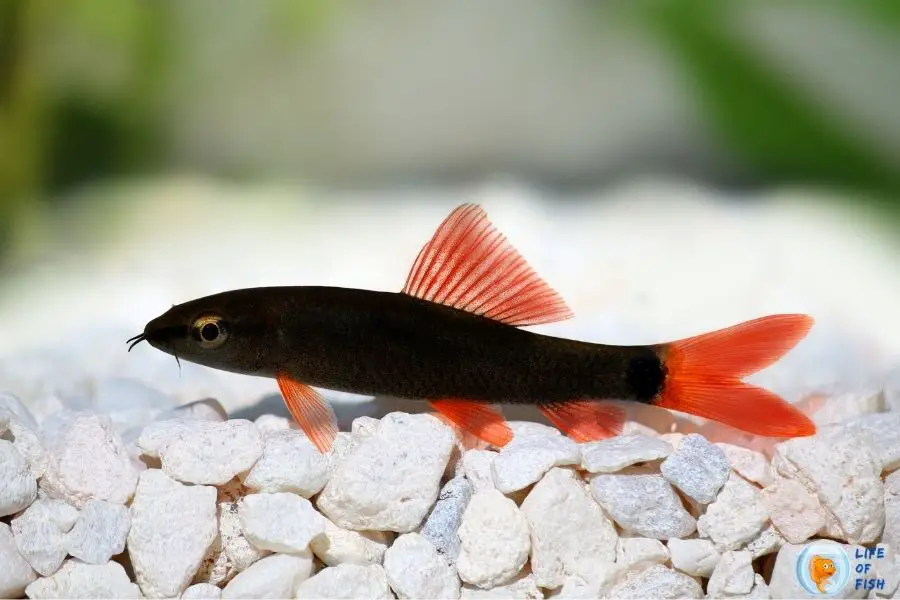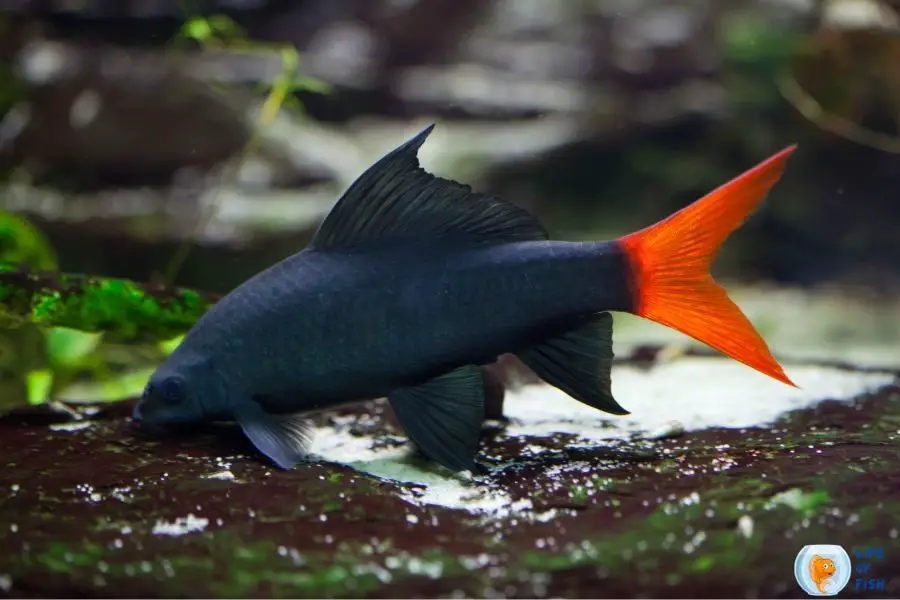Rainbow and Red Tail Shark are very much look-alike species that many aquarists get confused with. However, they are two different species that share so many similarities in diet, habitats, behavior, and tank requirements.
The best way to distinguish Rainbow and Red Tail Shark are to check their pectoral, dorsal and anal fins. These three fins of the rainbow shark are red, while in red tail shark is black.
However, both fish are exciting and beautiful species that will color up your freshwater aquarium.
Let’s find out more about the similarities and differences between Rainbow and Red Tail Shark from now on.

Rainbow shark
Rainbow Shark (Epalzeorhynchos frenatum) is also known as Ruby Shark, Red Finned Shark, Rainbow Shark Minnow, Green Fringe Lip, Whitefin Shark, Whitetail Shark Minnow, or Red Fin Shark.
These are small tropical freshwater aquatic animals. These species are viral in the aquarium market due to their semi-aggressiveness, color, and attitude.
The name rainbow shark was given due to their upright dorsal fin, giving the fish a shark-like appearance.
Native to Thailand, these freshwater Cyprinidae have a vibrant redfin and are very territorial. These fish originate from Southeast Asia warm rivers.
Keep in mind that these fish are somewhat challenging to keep in captivity unless the fish keeper has experience dealing with such species.
So, suppose you plan to take these fish as your aquatic pet.
In that case, it is advised to get guidance from a marine animal expert beforehand because these species need plenty of hiding spots since this will help them to reduce their territorial behavior.
Behavior of rainbow shark
These species are known for their aggressive and dominant behavior. The behavior changes usually happen as they develop into an adult.
Young Rainbow sharks are known to be feared species that spend a lot of time hiding.
Rainbow sharks are very active swimmers and like to spend a lot of time living in the bottom of the tank.
Because of this, these fish are also known as aquarium tank cleaners since they eat algae growing on the tank.
Even though they are known to be peaceful with the fish that live in higher water, they are very aggressive in their bottom territory levels and will even fight with their own kind.
These fights can lead to severe injuries such as biting, chasing, or being head to tail bumping.
To avoid such encounters, you can ensure that these fish get plenty of hiding space like caves, tunnels, or any other hollow decoration in your aquarium.
You must have a large tank with a smaller number of fish-to-water ratios.
Appearance
Rainbow shark fish can grow up to six inches in length when fully grown and live up to five to eight years.
These beautiful species are dark grey with a vibrant reddish-orange color fin. Rainbow shark fish has a long flat stomach and an upright dorsal fin, giving it an actual shark-like appearance.
Separating them from male to female is not possible when these fish are young. It is always recommended to wait till these fish fully develop and become adults to check their gender.
Identifying the gender – once fully grown, the male rainbow shark fish will have small black lines on the tail fin and look thin. Further, the female fish will have a very thick body.
Habitat
Rainbow sharks are highly active swimmers. So, when keeping an adult fish, make sure that your aquarium is not less than 50 gallons.
Also, keep in mind that your aquarium must have plenty of space horizontally. Because if you have an aquarium that is smaller in length, it will become more territorial and aggressive.
Rainbow sharks are very territorial species, as mentioned before. Ensure that you have plenty of hiding spots and lots of aquatic vegetation, which will reduce conflict and keep them distracted.
The fish would appreciate it if you could bring their natural habitat into the tank as closely as possible so try using sand to the bottom of your aquarium as this is what is found in the native Thai rivers.
Further, if you intend to use gravel, be cautioned because these are bottom dwellers, so the sharp point of the stones may harm your fish.
So, keep in mind using soft egged rock to avoid any unnecessary harm to the fish.
Always remember to check and see if the aquarium lid is closed because these fish can jump from the tank.
Tank Condition
For your aquarium fish to be healthy and happy, always follow the recommended parameters as mentioned below.
Keep in mind that your tank’s pH levels must always be stable when keeping these species because changes in pH level can cause them to become more aggressive than usual.
Aquarium lighting has to be kept at a medium level all-time, and the water flow has to be at a moderate speed.
Always try to replicate their natural environment as closely as possible. To do that, you can use sandy or gravel bottoms with lots of aquatic plantation-grown, which will help distract the fish from other inmates, and since these species need a lot of places to hide.
Make sure to fit in a few caves, tunnels, rocks at the bottom of your aquarium.
- Temperature 72°F and 8.1°F.
- pH levels 6.5 to 7.5
- Water Hardness 5 to 11 dH

Redtail shark
Redtail shark ( Epalzeortychos Biscolor, Syn Leabeo Bicolor) is also known as Red Tail Shark, Redtail Shark Minnow, Red Tail Back Shark, Red Tail Lebeo.
You can find these beautiful aquatic species in the clear waters and floodplains in the Menam Chao Playa Basin, Thailand.
These are small tropical freshwater fish currently listed as endangered species due to their extensive hunting.
Redtail Shark was thought to have become extinct. However, due to the growing aquarium trade, these species have been saved for somewhat levels.
Regardless of its name, this fish is a type of carp and belongs to the Cyprinidae family.
Behavior
Young redtail is known to be a fairly feared species. Due to this, you must provide them with enough hiding places in your aquarium.
Once there are fully developed adults, they will start to show signs of aggressiveness to fish who cross into their territory.
Even though these are highly territorial and aggressive fish, they will not harm the fish by biting or bumping. These fish will chase them till they become highly exhausted.
Ensure that while feeding the fish not to feed them closely to other fish. Otherwise, they will start to bully other fish.
Appearance
The redtail shark is a trendy aquarium fish due to its bicolor and it outstands the rest of its competitors. These fish have a beautiful deep black body color with a vibrant red forked tail.
The name comes from their dorsal fin. This finish will have a long slim body with flattened sides and a curved back.
You will notice its red eyes and its mouth has two pairs of barbs. This shape of the mouth will help them to scrape the algae off the bottom of the tank.
These species can grow up to six inches in captivity, with most growing up to five inches. And also, they will live for about six years.
When it comes to these species, gender rivals are pretty hard to see. However, the female fish is slightly more prominent, and the stomach area of the female fish can be seen in a greyish color rather than black.
Habitat
The redtail shark is a freshwater fish that lives in algae ponds of Thai. In rainy seasons these fish will inhabit the bottomlands, streams, and forest areas.
These are very active swimmers that will spend a lot of time just swimming and making themselves busy.
Like many other species over the past few years, the numbers of these beautiful red tail sharks have been reducing drastically due to hunting and industrial-grade farming.
Due to these inhuman actions, now, these species have been listed as endangered species.
Thanks to the developing interest for these aquatic animals in the aquarium market for breeding, these species still survive and multiply in captivity.
Tank Condition
Make sure that the young redtail shark fish have at least a 29 gallons size aquarium. And the adult fish must have at least a 55+ gallon aquarium for them to thrive.
Ensure to split the tank with many decorations such as rocks, caves, plants and driftwood to limit the amount of territorial behavior.
The decorations on the bottom will help to protect more feared tank mates. At the same time, these decorations will provide an environment similar to their natural habitats.
Make sure that the water conditions in the tanks are as follows.
- Temperature 72°F and 79°F.
- pH levels 6.8 to 7.5
- Water Hardness 5 to 15 dH
Always keep in mind that the water flow has to be steady and fast. Try to replicate the natural environment as closely as possible.
It’s better to use sand, gravel, or pebbles as the substrate to imitate redtail shark’s native waters.

Similarities and Difference Between Rainbow shark and Red Tail Shark
| RAINBOW SHARK | REDTAIL SHARK | |
| Color | Dark grey with a vibrant reddish-orange color fin | Deep black body color with a vibrant red forked tail |
| Size | 6 Inches | 5 to 6 inches |
| Gender identification | Separating them from male to female is not possible when these fish are young. Once fully grown, the male rainbow shark fish will have small black lines on the tail fin and look thin. Further, the female fish will have a very thick body. | Gender identification is challenging at a young age. You should wait until the fish mature. The female fish is slightly more prominent, and the stomach area of the female fish can be seen in a greyish color rather than it being back. |
| Life Span | 5 to 8 years | 5 to 6 Years |
| Nature | Semi Aggressive | Semi Aggressive |
| Family | Cyprinidae | Cyprinidae |
| Minimum Tank Size | 50 Gallons | 55+ Gallons |
| Habitat | Aquatic Plants, Caves, Rocks, Tropical freshwater | Aquatic Plants, Caves, Rocks, Tropical freshwater |
| Compatibility | Moderate gets along with much freshwater fish | Moderate |
| Care Level | Easy / Moderate | Moderate |
| Diet | Omnivore | Omnivore |
Read Next: 7 Difference Between A Male And Female Ghost Shrimp
